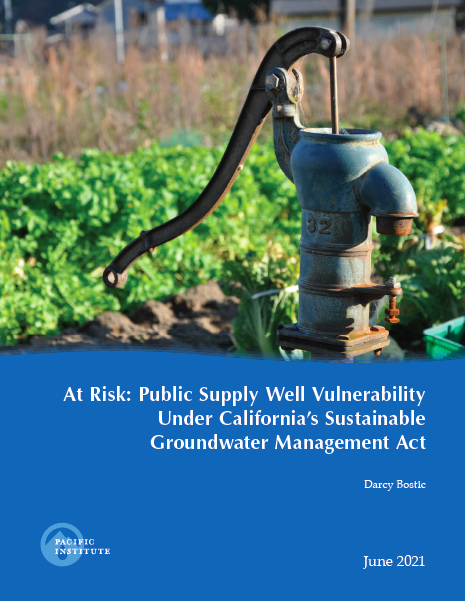At Risk: Public Supply Well Vulnerability Under California’s Sustainable Groundwater Management Act

At Risk: Public Supply Well Vulnerability Under California’s Sustainable Groundwater Management Act
Overview
Community water systems in California’s San Joaquin Valley face a host of challenges that threaten the safety and reliability of drinking water, including pollution, periodic drought, and chronic groundwater overdraft. Moreover, shallow wells, some of which serve community water systems, are vulnerable to short-term and chronic declines in groundwater levels. For example, during the 2012-2016 drought, many domestic wells and some public supply wells went dry.
California’s Sustainable Groundwater Management Act was designed to prevent significant and unreasonable chronic lowering of groundwater levels across the state, among other undesirable effects. Yet implementation often does not protect shallow wells. This report examines public drinking water supply well vulnerability under the Sustainable Groundwater Management Act. It focuses on wells and water systems in the San Joaquin Valley due to the area’s social and economic significance, high concentration of water-related challenges, and availability of developed groundwater sustainability plans.
The report finds that 503 of the 1,200 public supply wells in the region, or 42%, are likely to be partially or fully dry at the minimum thresholds established in the region’s sustainability plans. It includes recommendations to support small water systems and domestic wells and improve the resilience of groundwater sustainability Plans, in line with the state’s Human Right to Water.
Key Findings
Key findings from the report include:
- An estimated one million people are served by water systems that have at least 30% of their wells vulnerable to minimum thresholds. Small water systems and water systems serving populations whose households make less than $75,000 per year are more likely to have impacted wells.
- The minimum thresholds outlined in San Joaquin Valley groundwater sustainability plans do not protect drinking water access for a significant number of public supply wells (PSWs). Some PSWs will inevitably go dry before GSAs begin actively managing groundwater, especially if extended drought returns. To effectively support the Human Right to Water, well protection analyses should be included in future GSPs.
- Across the San Joaquin Valley, the average minimum threshold is 100 feet below the average 2019 water level. The report finds that 503 of the 1,200 public supply wells, or 42%, are likely to be partially or fully dry at minimum thresholds established in these sustainability plans.
- All groundwater sustainability plans have at least one public supply well that could be impacted at minimum threshold groundwater levels. Tule and Kaweah subbasins have the highest percentage of impacted wells, with just 20% of wells remaining active under minimum thresholds. Conversely, the Kings subbasin maintains groundwater levels that allow more than 90% of their wells to remain active.
- Declining groundwater levels will impact nearly 70% of systems, or 144 out of 214,. Forty percent of water systems reliant on one well are likely to have a partially or fully dewatered well at minimum threshold water levels.

